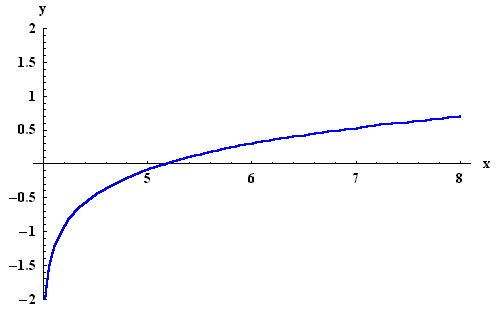 SOLVING LOGARITHMIC EQUATIONS
SOLVING LOGARITHMIC EQUATIONS SOLVING LOGARITHMIC EQUATIONS
SOLVING LOGARITHMIC EQUATIONS
Note:
Solve for x in the following equation.
Example 1:
The above equation is valid only if all the terms in the equation are valid.
The term
![]() is valid if
is valid if
![]() the term
the term
![]() is valid if
is valid if
![]() and the term
and the term
![]() is
valid if
is
valid if
![]() The domain is the set of real numbers
that are greater than 2, greater than 4, and greater than 1. The domain is
therefore the set of real numbers greater than 4.
The domain is the set of real numbers
that are greater than 2, greater than 4, and greater than 1. The domain is
therefore the set of real numbers greater than 4.
This is a complex equation because all the bases are different. Let's solve it first by graphing; we do this by changing all the bases to either 10 or e. Why do we change the bases to either 10 or e? Because most calculators have these functions.
Change the original equation into an equation where all the logarithmic
terms have base e.

Rewrite the equation as

Let's call the left side of the equation f(x) and the right side of the equation g(x).
Then
 and
and
![]() Graph f(x) and g(x). We are looking for the
point(s) of intersection,
Graph f(x) and g(x). We are looking for the
point(s) of intersection,
![]() The solution, if any, will
be the value of x in the point(s) of intersection.
The solution, if any, will
be the value of x in the point(s) of intersection.
The graph of the right side of the equation is the set of points where the value of y equals zero. This is easy; it is just the x-axis. We then look to see where the graph of f(x) crosses the x-axis.
Note that the graph only appears to the right of x=4. This is consistent with our finding that the domain of the original equation is the set of real numbers greater than 4.
The solution(s) to the original equation is the set of real numbers where f(x) crosses the x-axis. (The x-intercepts are the solutions to the problem.) You will note from the graph that f(x) crosses the x-axis at about 5.1797. This means that the equation has one real solution at x=5.1797.
 |
The algebraic solution is too difficult for a beginning student. Clearly, graphing is the easiest way to determine the answer.
If you would like to work another example, click on example.
If you would like to test yourself by working some problems similar to this
example, click on problem.
If you would like to go to the next section, click on next.
If you would like to go back to the previous section, click on previous.
If you would like to go back to the equation table of contents, click on
contents.
This site was built to accommodate the needs of students. The topics and problems are what students ask for. We ask students to help in the editing so that future viewers will access a cleaner site. If you feel that some of the material in this section is ambiguous or needs more clarification, or you find a mistake, please let us know by e-mail.

